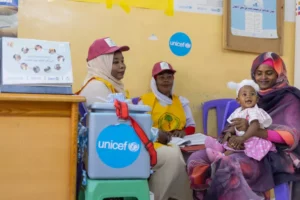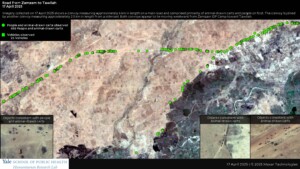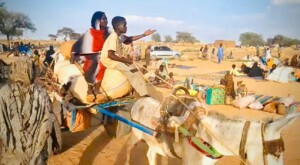More than 417,000 South Sudanese refugees in Sudan: UNHCR
According to the UN Refugee Agency (UNHCR), more than 417,000 South Sudanese refugees are sheltering in Sudan since conflict broke out in December 2013.
Almost 137,000 refugees arrived from South Sudan so far this year, which is more than the total number of arrivals in 2016, the UN office of the Coordination of Humanitarian Affairs (OCHA) in Sudan cites UNHCR in its latest news bulletin.
During the first half of May, almost 20,000 refugees sought assistance in Sudan as a result of ongoing hostilities in Kodok in Upper Nile state. This includes 13,645 refugees in White Nile, and a further 5,261 in South Kordofan.
According to the UN Refugee Agency (UNHCR), more than 417,000 South Sudanese refugees are sheltering in Sudan since conflict broke out in December 2013.
Almost 137,000 refugees arrived from South Sudan so far this year, which is more than the total number of arrivals in 2016, the UN office of the Coordination of Humanitarian Affairs (OCHA) in Sudan cites UNHCR in its latest news bulletin.
During the first half of May, almost 20,000 refugees sought assistance in Sudan as a result of ongoing hostilities in Kodok in Upper Nile state. This includes 13,645 refugees in White Nile, and a further 5,261 in South Kordofan.
This latest influx has put additional pressure on service provision in camps and settlement sites, prompting UNHCR and partners to step up efforts to achieve minimum emergency standards as quickly as possible.
Contingency plans have also been developed to respond to possible further influxes; according to newly arrived refugees, many people are on their way from South Sudan’s Attara, Fashoda, and Kaka in Upper Nile.
Some 9,000 South Sudanese refugees arrived in East and South Darfur in the first half of May, according to UNHCR.
High malnutrition rates among refugee children in White Nile
UNHCR’s revised RRRP states that increased food assistance to South Sudanese refugees remains of paramount importance, as a nutrition assessment carried out across refugee sites in White Nile state in October 2016 identified a Global Acute Malnutrition (GAM) rate higher than 15 percent, as well as a Severe Acute Malnutrition (SAM) prevalence of over 2 percent (critical).
The nutritional status of South Sudanese refugees remains a pressing concern, as those entering Sudan are coming from areas currently facing emergency levels of acute malnutrition. Furthermore, in some sites in White Nile, 40 percent of the population is food insecure according to WFP’s recent household food security assessment, while 54-94 percent of camp-based South Sudanese refugees cannot afford to buy food.
The main drivers of food insecurity are the lack of livelihood opportunities, limited access to cooking fuel, restriction of movement in some areas, high prices on local commodities and limited access to land for farming, according to UNHCR. In some cases, refugees are sharing their food with others, or are forced to sell a portion to meet other needs, which effectively reduces their ration.
Overall, the South Sudanese refugee crisis is a children’s emergency, with children making up more than 65 per cent of the refugee population. Approximately 88 percent of the refugees are women and children.
Sudan’s response to South Sudanese refugee influx
OCHA further reports that the Sudanese government maintains an open border to receive South Sudanese refugees and guarantees their safety in Sudan. South Sudanese refugees in general have been able to move freely in hosting states, and access some employment opportunities and public services.
In September 2016, the Government of Sudan officially recognised the South Sudanese as refugees, following the signing of a Memorandum of Understanding with UNHCR. The government has encouraged an early recovery and development approach alongside the humanitarian response for South Sudanese refugees. This will provide opportunities to enhance solutions for refugees, and provide much-needed support to refugee-hosting communities, the OCHA bulletin reads.
However, there is currently limited funding support to address the humanitarian needs of vulnerable refugees in Sudan, which is having an impact on their ability to cope. In the absence of adequate assistance and in the face of continuing influx, South Sudanese refugees’ coping strategies are further limited and some may seek to move onwards to improve their situation, or be at risk of being targeted by traffickers.
More than $220 million needed for Sudan
On 15 May, UNHCR and the World Food Programme (WFP) launched in Geneva a revised Regional Refugee Response Plan (RRRP) urging donors to step up support for South Sudanese fleeing their country. Humanitarian agencies are seeking $1.4 billion to provide life-saving aid to 1.8 million South Sudanese refugees in the six neighbouring countries, including Sudan, until the end of 2017.
The Sudan portion of the RRRP is less than 10 percent funded.
The 2017 RRRP for South Sudan had initially planned for 330,000 refugees arriving in Sudan by the end of the year. However, their total number in Sudan had already reached 376,000 by 30 April 2017, surpassing the planned figure in the first quarter of the year.
In light of the accelerated pace of the influx, RRRP partners agreed to undertake a revision to increase the total planning figure to 477,000 by year-end. This increase in the planning figure was the basis for the revision of the Sudan chapter of the RRRP, OCHA reported.











 and then
and then